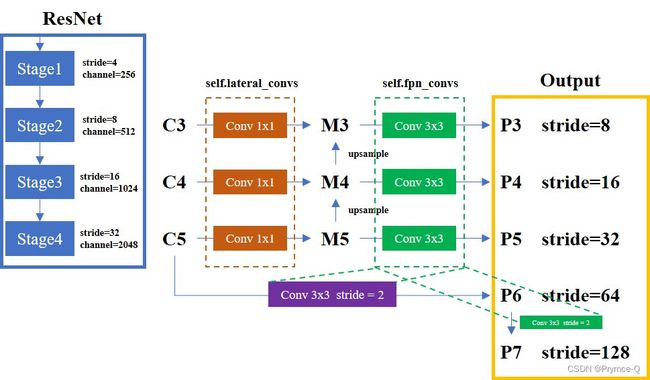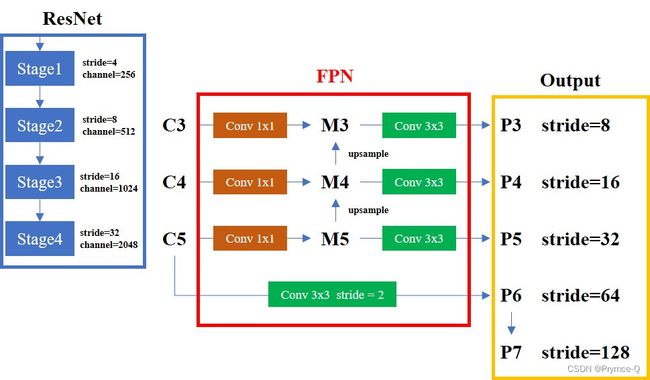【MMDet Note】MMDetection中Neck之FPN代码理解与解读
文章目录
- 前言
- 一、总概
- 二、代码解读
-
- 1.FPN类
- 2.def forward
- 总结
前言
mmdetection/mmdet/models/necks/fpn.py中FPN类的个人理解与解读。
一、总概
本文以mmdetection/configs/base/models/retinanet_r50_fpn.py中的RetinaNet配置参数为例进行分析。
以下是RetinaNet模型的Neck参数配置:
neck=dict(
type='FPN',
# in_channal对应ResNet输出的4个尺度特征图channel数
in_channels=[256, 512, 1024, 2048],
# FPN 输出的每个尺度输出特征图通道
out_channels=256,
# in_channels对应的特征图从index=1开始用,即FPN用了后三个特征图
start_level=1,
# 额外输出层的特征图来源
add_extra_convs='on_input',
# FPN 输出特征图个数为5, stride = 8,16,32,64,128
num_outs=5),
二、代码解读
1.FPN类

代码的标注#都是以RetinaNet的config为例的哦~~代码解读与图片中的内容是互相对应的!!!
@NECKS.register_module()
class FPN(BaseModule):
def __init__(self,
in_channels, # RetinaNet为例 [256, 512, 1024, 2048]
out_channels, # 256
num_outs, # 5
start_level=0, # 1
end_level=-1,
add_extra_convs=False, # 'on_input'
relu_before_extra_convs=False,
no_norm_on_lateral=False,
conv_cfg=None,
norm_cfg=None,
act_cfg=None,
upsample_cfg=dict(mode='nearest'),
init_cfg=dict(
type='Xavier', layer='Conv2d', distribution='uniform')):
super(FPN, self).__init__(init_cfg)
assert isinstance(in_channels, list)
self.in_channels = in_channels # self.in_channels = [256, 512, 1024, 2048]
self.out_channels = out_channels # self.out_channels = 256 对应图中M3-M5的channel数为256
self.num_ins = len(in_channels) # self.num_ins = 4
self.num_outs = num_outs # self.num_outs = 5 对应图中P3-P7
# 下面4个参数对于结构理解关系不大
self.relu_before_extra_convs = relu_before_extra_convs
self.no_norm_on_lateral = no_norm_on_lateral
self.fp16_enabled = False
self.upsample_cfg = upsample_cfg.copy() # 上采样参数
if end_level == -1 or end_level == self.num_ins - 1:
self.backbone_end_level = self.num_ins # self.backbone_end_level = 4
assert num_outs >= self.num_ins - start_level
else:
# if end_level is not the last level, no extra level is allowed
self.backbone_end_level = end_level + 1
assert end_level < self.num_ins
assert num_outs == end_level - start_level + 1
self.start_level = start_level # self.start_level = 1
self.end_level = end_level # self.end_level = -1
self.add_extra_convs = add_extra_convs # self.add_extra_convs = 'on_input'
assert isinstance(add_extra_convs, (str, bool))
if isinstance(add_extra_convs, str):
# Extra_convs_source choices: 'on_input', 'on_lateral', 'on_output'
assert add_extra_convs in ('on_input', 'on_lateral', 'on_output')
elif add_extra_convs: # True
self.add_extra_convs = 'on_input'
self.lateral_convs = nn.ModuleList() # 对应图中橙色虚线框
self.fpn_convs = nn.ModuleList() # 对应图中绿色虚线框
for i in range(self.start_level, self.backbone_end_level): # start_level = 1, backbone_end_level = 4,整体数量为3
# 构造conv 1x1,对应图中3个橙色矩阵
l_conv = ConvModule(
in_channels[i],
out_channels,
1, # kernel_size = 1
conv_cfg=conv_cfg,
norm_cfg=norm_cfg if not self.no_norm_on_lateral else None,
act_cfg=act_cfg,
inplace=False)
# 构造conv 3x3,对应图中3个绿色矩阵
fpn_conv = ConvModule(
out_channels,
out_channels,
3,
padding=1,
conv_cfg=conv_cfg,
norm_cfg=norm_cfg,
act_cfg=act_cfg,
inplace=False)
self.lateral_convs.append(l_conv)
self.fpn_convs.append(fpn_conv)
# 添加额外的conv level (e.g., RetinaNet)
extra_levels = num_outs - self.backbone_end_level + self.start_level # extra_levels = 5 - 4 + 1 = 2
# 其实不论怎么样这个extra_levels都会>=1(当前理解的也就是,在默认情况下图中的Output中的绿色矩形始终存在)
if self.add_extra_convs and extra_levels >= 1:
for i in range(extra_levels): # 2
if i == 0 and self.add_extra_convs == 'on_input': # 当i == 0时,满足条件
in_channels = self.in_channels[self.backbone_end_level - 1] # 当i == 0时,in_channels = in_channels[3] 也即2048,此时构造的对应图中紫色的矩阵
else: # 当i == 0时,in_channels = 256
in_channels = out_channels
# 构造conv 3x3, stride=2
extra_fpn_conv = ConvModule(
in_channels,
out_channels,
3,
stride=2,
padding=1,
conv_cfg=conv_cfg,
norm_cfg=norm_cfg,
act_cfg=act_cfg,
inplace=False)
self.fpn_convs.append(extra_fpn_conv)
# 因此RetinaNet最终fpn_convs中有5块Conv块,即对应图中绿色虚线框关联的内容有5块
2.def forward
这里重新贴一下上面的图,代码解读与图片中的内容是互相对应的!!!

@auto_fp16()
def forward(self, inputs):
"""Forward function."""
assert len(inputs) == len(self.in_channels)
# laterals 用来记录每一次计算后的输出值,可以理解成是一个临时变量temp
laterals = [
lateral_conv(inputs[i + self.start_level]) # self.start_level = 1,inputs[i + 1]为C3-C5的输入
for i, lateral_conv in enumerate(self.lateral_convs)
]
# 此时,laterals 已经记录了C3-C5经过conv 1x1之后得到的M3-M5值(还未upsample)
# build top-down path
used_backbone_levels = len(laterals) # 3
for i in range(used_backbone_levels - 1, 0, -1): # i in [2,1]
# In some cases, fixing `scale factor` (e.g. 2) is preferred, but
# it cannot co-exist with `size` in `F.interpolate`.
if 'scale_factor' in self.upsample_cfg:
# fix runtime error of "+=" inplace operation in PyTorch 1.10
laterals[i - 1] = laterals[i - 1] + F.interpolate(
laterals[i], **self.upsample_cfg)
else:
# 这里也就是upsample与相加的操作,可以理解成经过“upsample”与“+”的操作后,才得到真正的M3-M5的值
prev_shape = laterals[i - 1].shape[2:]
laterals[i - 1] = laterals[i - 1] + F.interpolate(
laterals[i], size=prev_shape, **self.upsample_cfg)
# 此时,laterals 记录了经过upsample之后得到的新M3-M5值
# 建立 outputs
# part 1: from original levels 此处out对应P3-P5
outs = [
self.fpn_convs[i](laterals[i]) for i in range(used_backbone_levels) # used_backbone_levels = 3
]
# part 2: add extra levels
if self.num_outs > len(outs): # self.num_outs = 5
# use max pool to get more levels on top of outputs
# (e.g., Faster R-CNN, Mask R-CNN)
if not self.add_extra_convs: # self.add_extra_convs = 'on_input'
for i in range(self.num_outs - used_backbone_levels):
outs.append(F.max_pool2d(outs[-1], 1, stride=2))
# add conv layers on top of original feature maps (RetinaNet)
else:
if self.add_extra_convs == 'on_input': # 满足条件
extra_source = inputs[self.backbone_end_level - 1] # self.backbone_end_level - 1 = 3 , extra_source 对应图中的C5
elif self.add_extra_convs == 'on_lateral':
extra_source = laterals[-1]
elif self.add_extra_convs == 'on_output':
extra_source = outs[-1]
else:
raise NotImplementedError
# 此处outs增加P6
outs.append(self.fpn_convs[used_backbone_levels](extra_source)) # self.fpn_convs[used_backbone_levels]对应图中紫色的矩阵
for i in range(used_backbone_levels + 1, self.num_outs): # i in [4]
if self.relu_before_extra_convs:
outs.append(self.fpn_convs[i](F.relu(outs[-1])))
else:
# 此处out增加P7
outs.append(self.fpn_convs[i](outs[-1])) # self.fpn_convs[i]对应con3x3,stride=2 outs[-1]对应P6 这里也对应了之前提到的“在默认情况下图中的Output中的绿色矩形始终存在”
return tuple(outs)
总结
本文仅代表个人理解,若有不足,欢迎批评指正。
参考:
【夜深人静读MM】MMdetection框架之Neck中的FPN解读
轻松掌握 MMDetection 中常用算法(一):RetinaNet 及配置详解
